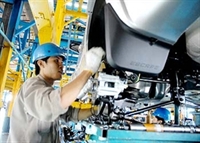
| Vietnam overcoming crisis better than other countries | ||
A report on the Vietnam’s economy in the first half of this year released by the World Bank reaffirms that Vietnam has overcome the global economic crisis better than other countries. As in previous years, Vietnam has not seen a bank crisis, despite several instabilities in the macroeconomy. The WB said that the results are thanks to the Government’s timely reaction to changing the economic situation. Over the past three years, Vietnam’s economy has shifted from regular growth to rapid development and then to stability, stimulus and a rebalancing of the economy. The Vietnamese Government has not spent a lot of time on adjusting policies. Recently, a major stimulus package together with tax exemptions, an increase in Government spending and rapid credit growth has helped to promote domestic consumption and maintain economic growth. In particularly, exports of goods and services still accounted for 67 percent of GDP, despite the impact of the global crisis in 2009. However, the report said that Vietnam could do even better if information was better disseminated. Currently the market does not have a clean enough picture of what the Government intends to do.
| ||
| Vninfogate.Com |
